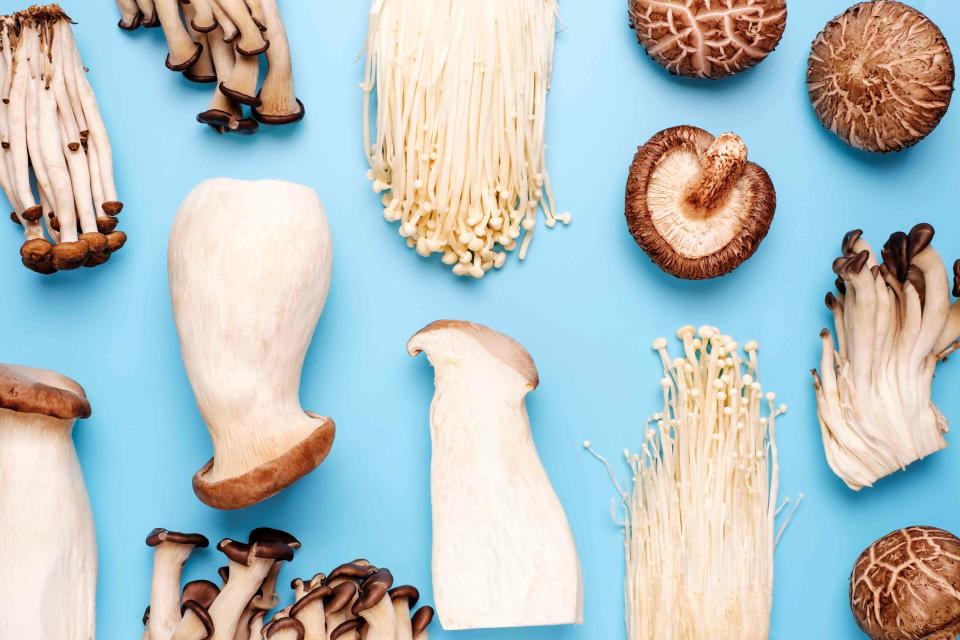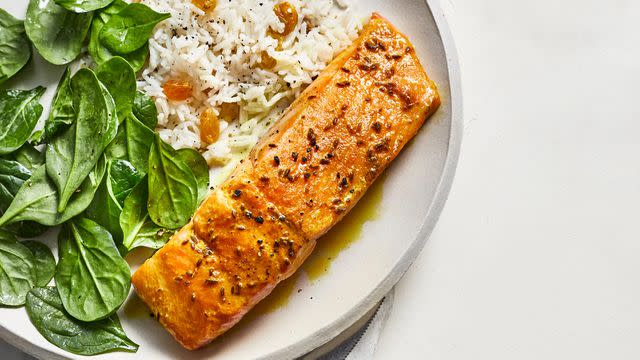The 3 Newest Superfoods for 2024, According to Hundreds of Registered Dietitians
And they're refreshingly recognizable.

Tatiana/Getty Images
You probably already knew that foods like fish, mushrooms, beans, and lentils are good for you—but did you know that nutrition experts consider some of them to be superfoods?
Pollock Communications and Today's Dietitian surveyed 564 registered dietitians for its annual "What's Trending in Nutrition" survey, and the results reveal a list of the top 10 most exceptional, nutrient-dense foods that are officially trending for 2024. Most notably, salmon, pulses, and mushrooms are new to the lineup, joining previous years’ repeat superfoods such as fermented foods, blueberries, avocados, and green tea.
What exactly is a superfood?
The truth is that “superfood” isn’t really a technical term for which there is a clear-cut, formal definition. It’s a word that’s come to describe certain foods (and beverages) that are exceptionally high in vital nutrients and come with important functional health benefits. Put simply: “Generally, a ‘superfood’ is an excellent source of several important nutrients,” says Tracy Gensler, MS, RD, registered dietitian and science writer at Pollock Communications.
Top 10 Superfoods for 2024
This year, the following 10 foods were named the most worthy of superfood status, according to hundreds of nutritionists who participated the "What's Trending in Nutrition" survey:
Fermented Foods
Blueberries
Seeds
Avocado
Nuts
Green Tea
Pulses
Mushrooms
Ancient Grains
Salmon
The 3 New Superfoods on the List for 2024
While 2023’s top superfoods list saw some novel, intriguing, and even surprising newcomers in the top 10—aquatic greens and plant-based milks!—slightly more familiar grocery items, including salmon, pulses (a type of legume), and mushrooms, have bumped those buzzy products from the ranking this year. Here’s why pulses, mushrooms, and salmon are getting special attention right now.
1. Pulses

Spiced Rice With Crispy Chickpeas
What’s a pulse, you ask? Pulse is the more precise term for several foods commonly referred to simply as legumes, because they are a part of the legume family; however, they are, more technically, pulses: the edible seeds from inside a legume plant that are harvested dry. The pulse group includes foods you already know and love, such as beans, chickpeas, lentils, and dry peas. (Other types of legumes besides pulses include soybeans, peanuts, and fresh peas.)
What makes these little guys so special? As complex carbohydrates, pulses are excellent sources gut-healthy fiber and slow-burning energy, as well as plant protein, iron, magnesium, folate, and potassium (1 cup of cooked lentils contains 16% of the daily value (DV) of potassium).
“[Pulses] are so nutrient-rich that they’re classified as both a protein and a vegetable in the Dietary Guidelines for Americans,” says Gensler. She adds that pulses are particularly good sources of soluble fiber, which helps manage blood cholesterol levels. “Soluble fiber is fermented by bacteria in the colon, producing short-chain fatty acids that have anti-inflammatory and health protective effects,” she explains.
Tips to Shop for and Prepare Pulses
Beans of all kinds, lentils, dry or split peas, and chickpeas (aka garbanzo beans) are common and available pulses. “Feel free to use canned, no-salt-added pulses, dried pulses, and dehydrated pulses,” Gensler says.
She also notes that while these legumes are often avoided for fear of causing bloating or gas, there isn’t as much to fear as we think. If you don’t eat lentils or beans very often, for instance, start slow and small, because increasing your fiber intake too rapidly or too much at once (and without drinking enough water!) is what can lead to GI discomfort.
“A brand-new [small] randomized clinical trial showed that people consuming about ¾ cup lentils every day did not experience GI distress,” she says. “The study…found that consuming an average of about ¾ cup of cooked lentils daily for 12 weeks was helpful in lowering cholesterol and postprandial glycemic and inflammatory responses. This shows that daily consumption of lentils can be a safe and effective food strategy to improve metabolic health without increased GI distress.”
Related: 7 Ways to Use Chickpeas (That Don't Involve Hummus)
2. Mushrooms

Creamy Mushroom Soup With Chives
Welcome to the superfood club, edible fungi! According to the survey, RDNs have officially moved mushrooms into the winners’ circle as the eighth trendiest superfood of the year. Hearty and flavorful, mushrooms are a versatile plant food that deserve a spot in your weekly meal rotation.
They may not look as bright and colorful on the outside as other fruits and veggies, but edible mushrooms of all varieties—from creminis to portobellos, to buttons, to maitakes—contain similarly impressive profiles of powerful micronutrients and plant compounds. These include cognition-supporting and immunity-boosting vitamins and minerals like vitamin A, several B vitamins, vitamin D, and more. Most notably, Gensler adds, mushrooms are “rich in fiber, selenium, potassium, and copper; antioxidant compounds that help the body battle oxidative stress linked to tissue damage, chronic diseases and aging.”
Tips to Shop for and Prepare Mushrooms
Gensler recommends buying mushrooms in pretty much any form: canned, no-salt-added mushrooms, frozen mushrooms with no added salt, and fresh, are all great and “equally healthy.”
“You can roast fresh mushrooms tossed in olive oil and minced garlic in the oven,” she says, “or for canned and frozen, saute on medium heat with olive oil and fresh, minced garlic or garlic powder, and a little bit of less-sodium soy sauce.”
Related: 10 Mouthwatering, Easy-to-Make Mushroom Recipes
3. Salmon

Perhaps the most talked-about and recommended fatty fish, salmon has finally landed itself among its superfood peers, per RDNs across America. All seafood, including salmon, is a rich source of lean protein. Salmon also contains heart-healthy “omega-3 fatty acids eicosapentaenoic acid (EPA) and docosahexaenoic acid (DHA), which benefit neurological health and cell membranes and can lower blood triglyceride levels,” Gensler says. “High triglyceride levels, along with high levels of low-density lipoproteins (LDL) and low levels of high-density lipoproteins (HDL), is linked to accumulation of fatty buildup within artery walls, which can increase risk for a heart attack or stroke.”
Tips to Shop for and Prepare Salmon
“According to the Monterey Bay Aquarium Seafood Watch Guide, it's important to consider buying sustainable salmon,” Gensler shares. This handy guide will point you in the right direction of which salmon to buy and from where, and which types to avoid. You can even download the Monterey Bay Aquarium Seafood Watch app! It categorizes species into the categories "Best Choices," "Good Alternatives," and "Avoid," so you can find the best options at the fish store, grocery store, or out at restaurants.
Find tasty salmon recipes right here, plus more tips for cooking salmon that’ll make even fish-haters change their tune.
Related: The 30 Healthiest Foods to Eat Every Day
For more Real Simple news, make sure to sign up for our newsletter!
Read the original article on Real Simple.

